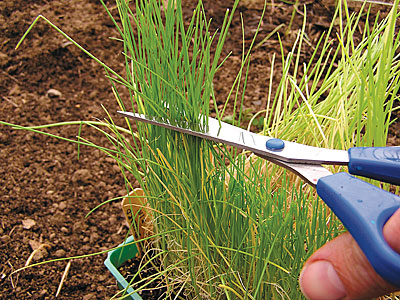 |
| Trim the tops of onion and leek seedlings to make the bases thicker. Use the trimmings in soups or salads. English photo. |
By Roberta Bailey
Pick yourself up, dust yourself off. Congratulations on surviving one of the roughest go-rounds with Mother Nature that most Maine gardeners can remember.
The fact that you are reading an article on gardening tips indicates that you are not ready to give up. The seeds of hope for next year are already sprouting … hope for a blight-free summer, for an abundant tomato crop, for more cucumbers, or winter squash, for doing a better job of weeding or getting cover crops planted or perfectly timing the late plantings of greens.
It seems that gardeners tend to be optimists. Like sunflowers following the setting sun then turning back to greet the first rays of morning, we collectively turn toward the next season and await the arrival of spring.
Here is a collection of gardening tips, gathered from people this fall. I must note that not one of them complained of the previous season as they reflected and shared. Many preferred to remain anonymous, citing that these weren’t really their own tips, just ones that they learned from other gardeners along the way. We all share in this science of life.
Late Winter
Maine’s gardening year starts in February or March. Early flowers, onions, leeks, celery and celeriac are among the first crops to be seeded. Adam Tomash and June Zellers start their onions in half gallon wax milk or juice cartons. The seedlings put down deep roots, thriving in all that space. When it’s time to transplant them into the garden, they simply shake the seedlings free of soil and free of each other, and plant.
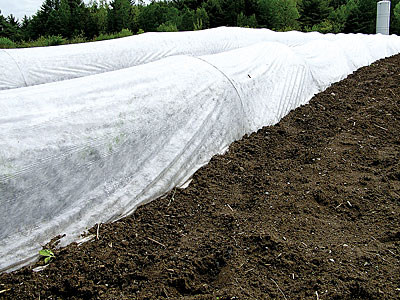 |
| Grow carrots under row covers to avoid carrot rust fly damage. English photo. |
I learned to trim my onion and leek tops with scissors every few weeks, to help thicken their bases. Sprinkle the trimmings on supper, the first harvest of the season.
Emily Cates of Vassalboro uses gallon milk jugs filled with finished compost to root cuttings of grapes and even apples. She uses powdered kelp and B vitamins on the soil surface to help the plants root. Wheat and other grain seeds also give off compounds that enhance rooting. Cates has gotten apple sucker wood to root this way. Will Bonsall of Industry, Maine, recommends putting a few pieces of willow in with cuttings to help plants root. (Michael Dirr, in his Manual of Woody Landscape Plants, says to cut young willow stems into small pieces, steep them in water, then put cuttings to be rooted in the extract and allow them to absorb it “for a period of time.” Willows give off a “willow rooting substance” that helps cuttings root.)
For the past seven years I have been growing winter greens in my house. I do have a sunroom, but any big sunny window should work. I use a 10- to 12-inch-deep crate or box lined with plastic (a trash bag works) and fill it with quality organic potting soil. Then I plant lettuce, mesclun, spinach and cilantro. I seed thickly and harvest thinnings, which makes space for more growth. I usually plant this box in early February, just as the days begin to lengthen. The thinnings feed us a little bit of fresh greens for months.
Early Spring
Once the snow retreats from the garden, it’s time to plant no-till greens. Spread some fine compost on top of open ground and sow spinach, lettuce, greens and cilantro seed. Cover the seed with a little more compost and row cover if you have it. Experiment with other greens and discover what grows well for you. Of course, an Eliot Coleman-style hoop house opens up an entire world of four-season harvest, but this is a simple gesture that takes only a few minutes on a March or April day when you are ready to be outdoors, and it’s not a big commitment.
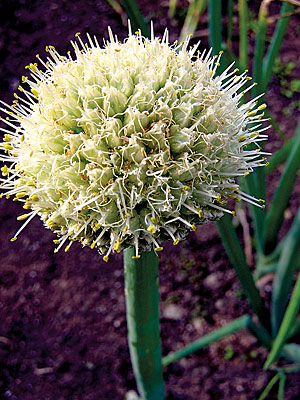 |
| Let some onions and carrots go to flower to attract beneficial insects. English photo. |
One gardener suggests planting carrots in blocks or beds for higher yields. A bed of three or four rows allows the roots to grow freely without close exposure to the compacted soil in the path. Another plants her onions and carrots in alternate rows within a bed, as the carrots form below ground and the onions form atop the soil. I used to interplant spinach with my onions, but found that the onions are such heavy feeders that I now grow them alone, digging a bit of a furrow and then filling it with compost and some form of nitrogen before transplanting into the covered row.
To avoid carrot rust fly damage, grow carrots under row cover from spring planting right until fall harvest.
If deer dig your carrots, cover the planting with row cover but let sections of it flap loosely in the wind. The flapping spooks the deer, whereas they will paw right through a well-anchored covering.
Leave a few carrots and onions to overwinter (or replant a few in early spring); the flowering heads of these biennials appear next year and attract beneficial insects to your garden.
Spring
Starting winter squash seeds indoors gives a jump on the season and the pests. Start seedlings in late April or early May in 4-inch pots. Avoid disturbing their roots when setting them out.
Asparagus is one crop that comes through year after year regardless of weather conditions. Place a slitted row cover over the row to encourage spears to emerge earlier, especially in chilly springs. When the asparagus harvest is over and the spears are growing into ferns, sow a row of spinach at the base of the row along its south side. Tending the spinach encourages you to pay more attention to an area that might otherwise become neglected and weedy. A crop of garlic can also be planted in the fall on the north side of the asparagus row, as it will get enough sun in the spring when the asparagus spears are being harvested to grow to a decent size by midsummer. Bear in mind that all are nitrogen lovers and extra nitrogen should be added.
When using row cover with wire hoops, a wider row can be covered by making a double arch, like an “M,” with two hoops overlapping each other side by side.
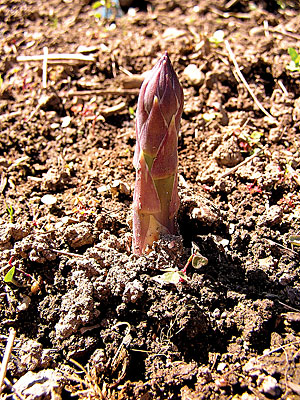 |
| Asparagus is one of the most dependable spring crops you can grow. English photo. |
Pepper plants respond well to a teaspoon of Epsom salts (magnesium sulfate) in the soil when setting them out.
Summer
In early August, once my garlic has been harvested, I use the well-mulched, fertile ground to plant a crop of fall spinach. I pull back the mulch, add a little organic Fertrell 3-2-3 to the rows and sow the seed. Spinach planted before mid-August gets huge, yielding much higher than later plantings. The rest of the former garlic patch becomes my fall greens and overwintering garden. Sometimes I interplant fall peas between the garlic rows in July. The peas are up about 6 to 12 inches when the garlic gets harvested, and there is a magical transition from garlic patch to pea patch.
Trellising is often a juggle between aesthetics, creativity, function and efficiency of assemblance. Heron Breen of St. Albans fences his corn patch with 4-inch-square net trellis on 6-foot posts. He plants peas along the side the corn will shade, pole beans and tomatoes on the trellis that gets most sun – and the deer don’t bother the corn.
Adam Tomash and June Zellers use 50-inch tall, 16-foot-long metal cattle fence panels to trellis their tomatoes and cucumbers. The panels are very sturdy and easy to clean in fall. Cucumbers hang through the arched trellis for easy picking. (Cattle panels are available through farm supply stores. See “In Search of the Perfect Tomato Trellis,” by Adam Tomash, The MOF&G, Dec. 2008-Feb. 2009.
Some find that a single strand of twine makes an easy tomato trellis, with no cages falling over and no difficulty in accessing plants. In each tomato row, lash poles to upright supports – either fence posts or tripods of lashed poles – and hang a strand or loop of twine from the pole down to the base of the tomato plant. As the plant grows just twist it around the twine. Pruning, trellising and picking are easy. Use a natural fiber twine such as hemp or jute for easy composting.
Make a great berry-picking bucket from a recycled plastic gallon vinegar bottle. Cut through the handle so that it can hook into your waistband or belt, and cut a wide opening in the side opposite the handle, usually from where the bottle starts to taper. Now your hands are free to pick.
As strawberry runners form from the mother plants, place them (still attached to the mother plant) in a container of soil, where they will root. The potted runners can be cut from the mother plant once they’re rooted, and kept until a new bed is ready, then easily transplanted.
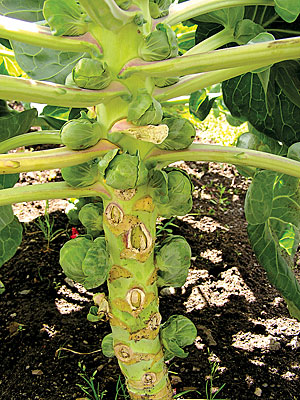 |
| Pinch off the tops of Brussels sprouts plants in early September to encourage the sprouts to enlarge. English photo. |
Late Summer
Remove the tops of Brussels sprouts plants in the first week of September to encourage the sprouts to fill out faster.
Ed Hamel of Jackson recommends planting oats in late August through September for next year’s mulch. The oats winter kill and are in place for a natural mulch on that piece of ground.
Megan Gerritsen of Wood Prairie Farm in Bridgewater plants ‘Dwarf Essex’ rapeseed in August, then turns it under in late October in preparation for growing potatoes the next year. The plowed down brassica releases bio-fumigants, which suppress harmful fungi and weed seeds.
Fall
To produce extremely large heads, garlic needs more space than is commonly recommended. The roots of a garlic head spread a few inches all around the plant.
Leave 10 inches between cloves to avoid root crowding. Feed them heavily with compost, nitrogen and azomite. The azomite increases the overall knob size and results in fewer small knobs. In early June give each plant 2 to 3 teaspoons of bloodmeal. Mulch helps regulate moisture. All alliums need ample moisture. Water them during droughts.
In fall, the Gerritsens pile their potato vines in the corn patch and burn them. The fire kills corn borers that may be in the corn stalks and destroys blight spores on the potato vines.
A hoop house is a great way to extend the season and harvest tomatoes free of late blight into autumn, plus lots of greens all winter.
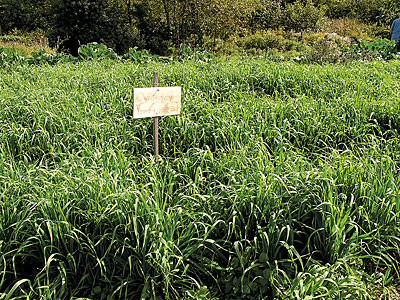 |
| Plant oats in late summer to grow your own mulch – as students at the Troy Howard Middle School in Belfast did. English photo. |
Finally, I leave you with the words that plant breeder Robert Schick, aka “relentless,” sent to me: “Food has become for me, and my wild agrarian plot, far more than our domesticated crops. Many of the so-called weeds have become my nourishment, part of my health necessity. In my plant breeding I’m heading into ‘uncharted terrain’ – ’releasing’ domesticated crops into the feral world, eventually back to their essence, their true authentic wild selves. This is where nutrition unleashed lies. I desire tough plants without a billion inputs from God knows where. It’s reconnecting, returning to our genetic connections, not attempting to supercede it. A space where our bodies once more feel at home and disease takes a hike. Welcome back wild world!”

